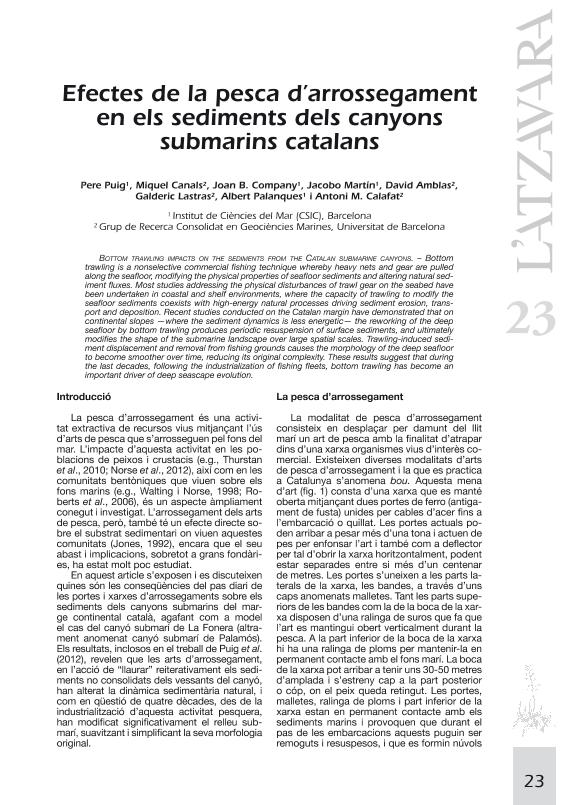Mostrar el registro sencillo del ítem
dc.contributor.author
Puig, Pere
dc.contributor.author
Canals, Miquel
dc.contributor.author
Company, Joan B.
dc.contributor.author
Martín de Nascimento, Jacobo

dc.contributor.author
Amblas, David
dc.contributor.author
Lastras, Galderic
dc.contributor.author
Palanques, Albert
dc.contributor.author
Calafat, Antoni M.
dc.date.available
2016-12-05T20:00:41Z
dc.date.issued
2014-06
dc.identifier.citation
Puig, Pere; Canals, Miquel; Company, Joan B.; Martín de Nascimento, Jacobo; Amblas, David; et al.; Efectes de la pesca d'arrossegament en els sediments dels canyons submarins catalans; Museo de Mataró; L'Atzavara; 23; 6-2014; 23-30
dc.identifier.issn
0212-8993
dc.identifier.uri
http://hdl.handle.net/11336/8815
dc.description.abstract
Bottom trawling is a nonselective commercial fishing technique whereby heavy nets and gear are pulled along the seafloor, modifying the physical properties of seafloor sediments and altering natural sediment fluxes. Most studies addressing the physical disturbances of trawl gear on the seabed have been undertaken in coastal and shelf environments, where the capacity of trawling to modify the seafloor sediments coexists with high-energy natural processes driving sediment erosion, transport and deposition. Recent studies conducted on the Catalan margin have demonstrated that on continental slopes —where the sediment dynamics is less energetic— the reworking of the deep seafloor by bottom trawling produces periodic resuspension of surface sediments, and ultimately modifies the shape of the submarine landscape over large spatial scales. Trawling-induced sediment displacement and removal from fishing grounds causes the morphology of the deep seafloor to become smoother over time, reducing its original complexity. These results suggest that during the last decades, following the industrialization of fishing fleets, bottom trawling has become an important driver of deep seascape evolution.
dc.format
application/pdf
dc.language.iso
cat
dc.publisher
Museo de Mataró
dc.rights
info:eu-repo/semantics/openAccess
dc.rights.uri
https://creativecommons.org/licenses/by-nc-sa/2.5/ar/
dc.subject
Arrossegament
dc.subject
Canyons Submarins
dc.subject
La Fonera
dc.subject.classification
Otras Ciencias de la Tierra y relacionadas con el Medio Ambiente

dc.subject.classification
Ciencias de la Tierra y relacionadas con el Medio Ambiente

dc.subject.classification
CIENCIAS NATURALES Y EXACTAS

dc.title
Efectes de la pesca d'arrossegament en els sediments dels canyons submarins catalans
dc.type
info:eu-repo/semantics/article
dc.type
info:ar-repo/semantics/artículo
dc.type
info:eu-repo/semantics/publishedVersion
dc.date.updated
2016-12-01T19:54:51Z
dc.identifier.eissn
2339-9791
dc.journal.volume
23
dc.journal.pagination
23-30
dc.journal.pais
España

dc.description.fil
Fil: Puig, Pere. Consell Superior d’Investigacions Científiques. Institut de Ciències del Mar; España
dc.description.fil
Fil: Canals, Miquel. Universidad de Barcelona; España
dc.description.fil
Fil: Company, Joan B.. Consell Superior d’Investigacions Científiques. Institut de Ciències del Mar; España
dc.description.fil
Fil: Martín de Nascimento, Jacobo. Consell Superior d’Investigacions Científiques. Institut de Ciències del Mar; España. Consejo Nacional de Investigaciones Científicas y Técnicas. Centro Austral de Investigaciones Científicas; Argentina
dc.description.fil
Fil: Amblas, David. Universidad de Barcelona; España
dc.description.fil
Fil: Lastras, Galderic. Universidad de Barcelona; España
dc.description.fil
Fil: Palanques, Albert. Consell Superior d’Investigacions Científiques. Institut de Ciències del Mar; España
dc.description.fil
Fil: Calafat, Antoni M.. Universidad de Barcelona; España
dc.journal.title
L'Atzavara
dc.relation.alternativeid
info:eu-repo/semantics/altIdentifier/url/http://www.raco.cat/index.php/Atzavara/article/view/302744
Archivos asociados
